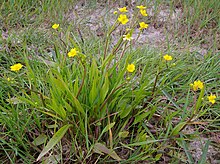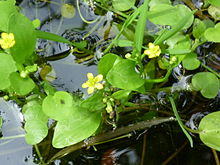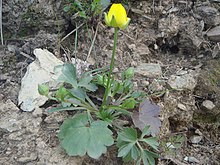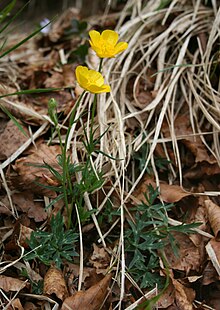Buttercup
| Buttercup | ||||||||||||
|---|---|---|---|---|---|---|---|---|---|---|---|---|

Field buttercup ( Ranunculus arvensis ), illustration |
||||||||||||
| Systematics | ||||||||||||
|
||||||||||||
| Scientific name | ||||||||||||
| Ranunculus | ||||||||||||
| L. |
The species-rich plant genus Ranunculus , including Ranunculus ( lat. Ranunculus ), belongs to the family of the buttercup family (Ranunculaceae). It occurs almost worldwide.
etymology
The common name buttercup refers to the bird's foot-like leaves. Since the Middle Ages, it has been used as a hanenvuoz, mostly for Ranuncula acees with three- to five-part leaves.
The botanical genus name Ranunculus is derived from the Latin word ranunculus for "little frog", either because many of the species thrive particularly in damp locations - where frogs also live, or because of their tadpole-shaped fruits ("little frog" = "tadpole").
description
Vegetative characteristics
Buttercup species grow as annual or perennial herbaceous plant . Most species thrive terrestrially, some species as swamp plants and a few species as flooding aquatic plants . Depending on the species, tuberous storage roots, rhizomes , stolons or a tuberous stem base can be formed. The upright, rising to prostrate, rarely flooding stem is usually leafy.
Most alternate, both basal and on the stem arranged distributed leaves can be stalked. The top pair of leaves is rarely opposite ( Ranunculus sect. Flammula ). The petiole has a leaf sheath at its base. The leaf blade can be undivided, usually it is more or less deeply divided. The leaf margin is smooth, notched, serrated or serrated.
Inflorescence and flowers
The flowers are solitary or two to fifty in terminal or lateral, simple or branched, up to 25 cm large, zymous inflorescences together. There may be small to large foliage-like bracts .
The hermaphroditic flowers are radial symmetry . The base of the flower (receptaculum) is more or less convex. The flower base sometimes forms an androgynophore , for example in Ranunculus angustisepalus . There are usually five (three to seven) free, 1 to 15 mm long sepals which are mostly green, sometimes dark red to purple, yellow or white; they are mostly flat and usually decay faster than the petals. Very rarely, in Ranunculus angustisepalus the sepals have appendages, or in Ranunculus ficaria the base is sack-shaped. The usually five (three to ten) free petals are often referred to as nectar leaves, they are nailed, flat, with a length of 1 to 26 mm linear to circular and have a nectar gland at their base, which is usually covered by a scale. The nectar leaves are often yellow and, due to drops of oil in the outermost epidermis, glossy inside, in some species they are also white, but then with a yellow center, very rarely they are red. There are usually many, rarely only five to ten, fertile stamens . The mostly many (4 to 250) free carpels are rarely stalked , for example in Ranunculus podocarpus . Each carpel contains only one basal ovule . Usually a stylus can also be seen on the fruit , rarely none is developed. Usually stigmatic tissue is distributed on the stylus, rarely a discernible scar is formed.
Fruits and seeds
There are many achenes together. The spherical, egg-shaped or cylindrical, more or less flattened achenes have a mostly smooth, sometimes warty or prickly surface and often a straight or curved 0 to 4.5 mm long fruit beak (= the durable stylus), sometimes they are edged at the seam or angular. The achenes are mostly green, only in Ranunculus melanogynus they are black. The seeds have a lot of endosperm and a small embryo .
Inheritance
The basic chromosome number is rarely x = 7, usually x = 8. Ranunculus has different levels of ploidy . Apomixis and interspecific hybridization occur in many groups (for example Ranunculus polyanthemos group, Ranunculus subg. Batrachium , Ranunculus sect. Pseudadonis ).
Ingredients and toxicity
All Ranunculus species are poisonous ( protoanemonin ). Because of their pungent taste, they are avoided by cattle. However, the toxins are broken down by drying, so that hay, which contains dried buttercups, is harmless. Mown stems can cause skin irritation on contact ( meadow dermatitis ).
Because of their caustic effect (from ranunculin or ranunculol and anemonin ) , buttercups were used medicinally , especially for some skin diseases. In particular, Asian buttercups , sharp buttercups , burning buttercups, and venom buttercups were previously used to treat genital warts , hemorrhoids, and skin ulcers .
distribution
The genus Ranunculus is distributed almost worldwide with over 600 species and occurs on all continents except Antarctica . Ranunculus species thrive from tropical to high-arctic regions. The main distribution area are the temperate areas of the northern hemisphere . There are around 76 species in North America . Over 60 species can be found in Central Europe . There are 125 species in China , 66 of them only there.
Ranunculus species thrive in dry to moist locations and as flooding aquatic plants. They occur from the lowlands to the high alpine altitudes . In the tropics, however, they only thrive in higher mountain areas, but are absent in the lowlands.
Systematics





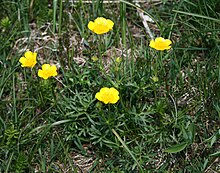









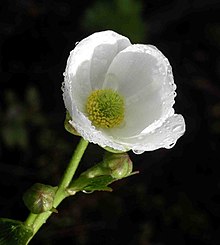





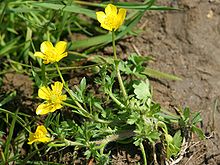



The genus name Ranunculus was first published in 1753 by Carl von Linné in Species Plantarum . Ranunculus auricomus L. was established as the lectotype in 1913 . The genus Ranunculus belongs to the tribe Ranunculeae in the subfamily Ranunculoideae within the family Ranunculaceae .
The structure of the genus Ranunculus is controversial, with some authors the sub-genera are listed as separate genera; This is also one of the reasons for the wide range in the specification of the number of species (from 300 to over 600). Synonyms for Ranunculus L. s. l. are: Aphanostemma A. St.-Hil. , Arcteranthis Greene , Batrachium (DC.) Gray , Casalea A. St.-Hil. , Gampsoceras Steven , Peltocalathos Tamura . According to K. Emadzade et al. In 2010 the tribe Ranunculeae contains a large genus Ranunculus with over 600 species and many small genera, newly or re-separated from it, with a total of around 50 species.
There are over 600 Ranunculus species (selection):
- Ranunculus abnormalis Cutanda & Willk. , Home: Spain and Portugal.
- Ranunculus abortivus L.
- Ranunculus acaulis DC.
- Ranunculus acetosellifolius Boiss. , Home: Spain (Sierra Nevada).
- Monkshood buttercup or monkshood buttercup ( Ranunculus aconitifolius L. )
- Ranunculus acriformis Gray A.
- Sharp buttercup ( Ranunculus acris L. )
- Ranunculus acutilobus Ledeb.
- Ranunculus adoneus A. Gray
- Ranunculus adoxifolius Hand.-Mazz.
- Hook buttercup ( Ranunculus aduncus Gren. ), Occurs only in Spain, France and Italy.
- Ranunculus ageri Bertol.
- Ranunculus albertii Regel & Schmalh.
- Ranunculus alismellus (A. Gray) Greene
- Ranunculus alismifolius Geyer ex Benth.
- Ranunculus allegheniensis Britton
- Ranunculus allenii B.L. Robinson
- Alpine buttercup ( Ranunculus alpestris L. )
- Ranunculus ambigens S. Watson
- Ranunculus amellus Briq.
- Ranunculus ampelophyllus Somm. & Levier
- White buttercup ( Ranunculus amplexicaulis L. ), native to the Pyrenees of Spain and France, thrives on mats at altitudes between 1000 and 2500 meters.
- Ranunculus amurensis Kom.
- Ranunculus andersonii A. Gray
- Ranunculus angulatus C. Presl , occurs only in Sicily.
- Ranunculus angustisepalus W.T.Wang
- Ranunculus apenninus (Chiov.) Pignatti , occurs only in Italy.
- Ranunculus apiifolius Pers.
- Common water crowfoot ( Ranunculus aquatilis L. )
- Ranunculus araraticus Grossh. ex Kem.-Nath.
- Ranunculus arizonicus Lemmon ex A. Gray
- Field buttercup ( Ranunculus arvensis L. )
- Asian buttercup , florist ranunculus ( Ranunculus asiaticus L. ), native to: Crete, Cyprus, Syria, Israel, Turkey, Northern Iraq, Western Iran, North Africa.
- Ranunculus astrantiifolius Boiss. ex Trautv.
- Ranunculus aureopetalus Kom.
-
Gold buttercup (species group; Ranunculus auricomus L. agg.), With numerous small species, including:
- Ranunculus allemannii Br.-Bl.
- Kashubian buttercup or Wenden buttercup ( Ranunculus cassubicus L. )
- Ranunculus fallax (Wimm. & Grab.) Sloboda
- Ranunculus megacarpus Walo Koch
- Ranunculus monacensis Borch.-Kolb. (endemic to Munich and the surrounding area)
- Ranunculus austro-oreganus L.D.Benson
- Ranunculus balangshanicus W.T.Wang
- Ranunculus balikunensis J.G. Liou
- Ranunculus banguoensis L.Liou
- Ranunculus barceloi gray , only occurs in Mallorca.
- Ranunculus batrachioides pomel , occurs in two subspecies in Spain, Sardinia, Algeria and Morocco.
- Ranunculus bilobus Bertol. , occurs only in the northern Italian Alps.
- Ranunculus biternatus Smith
- Ranunculus blankinshipii (BLRob.) A.Heller
- Ranunculus bonariensis Poir.
- Ranunculus borealis Trautv.
- Ranunculus brevifolius Ten. , occurs only in Italy, the former Yugoslavia, Greece, Crete and Turkey.
- Mountain buttercup , Rax buttercup, Hornschuch buttercup ( Ranunculus breyninus Crantz , Syn .: Ranunculus hornschuchii Hoppe , Ranunculus oreophilus M.Bieb. )
- Ranunculus breviscapus DC.
- Ranunculus brotherusii Freyn
- Ranunculus brutius Ten. , occurs in the Mediterranean area, but in Europe only in southern Italy, Greece and Turkey.
- Bulbous buttercup ( Ranunculus bulbosus L. )
- Ranunculus bullatus L. , Home: Mediterranean area.
- Ranunculus bupleuroides bread. , occurs only in Spain and Portugal.
- Ranunculus cacuminis Strid & Papan. , occurs only in Northern Greece.
- Ranunculus californicus Benth.
- Ranunculus cangshanicus W.T. Wang
- Ranunculus cantoniensis DC.
- Ranunculus canus Benth.
- Ranunculus caprarum Skottsb.
- Ranunculus cardiophyllus Hook.
- Carinthian buttercup or Carinthian buttercup ( Ranunculus carinthiacus Hoppe )
- Ranunculus carpaticus Herbich , only occurs in the Carpathian Mountains.
- Ranunculus caucasicus M.Bieb. , occurs in the Crimea, Asia Minor and the Caucasus.
- Ranunculus changpingensis W.T.Wang
- Ranunculus cheirophyllus Hayata
- Ranunculus chilensis DC.
- Ranunculus chinensis Bunge
- Ranunculus chinghoensis L.Liou
- Ranunculus chius DC. , occurs in the central and eastern Mediterranean region and in the Middle East.
- Ranunculus chuanchingensis L.Liou
- Spreading water crowfoot ( Ranunculus circinatus Sibth. )
- Ranunculus clethraphilus litard. , occurs only in Corsica.
- Ranunculus clypeatus (Ulbr.) Lourteig
- Ranunculus concinnatus Schott , occurs only in former Yugoslavia and Albania.
- Ranunculus concinnus (Hook.f.) Melville
- Constantinople Buttercup ( Ranunculus constantinopolitanus .. (DC) d'Urv , Syn .: R. villosus . DC . Subsp constantinopolitanus . (DC) Elenevskij ), home: Balkan Peninsula (missing in Greece), Cyprus, Crimea, the Caucasus, Northern Iraq, Iran , Syria.
- Ranunculus cooleyae Vasey & Rose
- Ranunculus Cordier Viv. , occurs only in Corsica and Sardinia.
- Ranunculus cornutus DC. , occurs in the European part of Turkey and in the Middle East.
- Ranunculus cortusifolius Willd. , occurs in the Azores and Madeira.
- Notched buttercup ( Ranunculus crenatus L. ), occurs on the Balkan Peninsula, in Austria, Romania and the Ukraine.
- Ranunculus creticus L. , occurs only in Greece, Crete, the Aegean Sea, Asia Minor and Libya.
- Ranunculus crimaeus Juz. , only occurs in Crimea.
- Ranunculus cuneifolius Maxim.
- Ranunculus cupreus Boiss. & Hero. , an endemic to Crete.
- Ranunculus cymbalaria Pursh , is native to North America, Central and East Asia, but is also introduced in Norway and Finland.
- Ranunculus cymbalariifolius Balb. ex Moris , home: Sardinia.
- Ranunculus degenii Kümmerle & Jáv.
- Ranunculus demissus DC. , occurs in Spain, on the Balkan Peninsula and in Western Asia.
- Ranunculus densiciliatus W.T.Wang
- Ranunculus dichotomus Moc. & Sessé ex DC.
- Ranunculus dielsianus ulbr.
- Ranunculus diffuse DC.
- Ranunculus dingjieensis L.Liou
- Ranunculus dissectus M.Bieb. , occurs in Crimea and Asia Minor.
- Ranunculus distans Royle
- Ranunculus dongrergensis Hand.-Mazz.
- Ranunculus donianus Pritz.
- Ranunculus elegans C. Koch
- Ranunculus eschscholtzii Schltdl.
- Ranunculus extensus (Hook. F.) Schilbe. ex Engl.
- Ranunculus fascicularis Muhl. ex Bigelow
- Ranunculus fasciculatus Sessé & Moc.
- Ranunculus felixii H.Lév.
- Ranunculus fibrosus pomel
- Ranunculus ficariifolius H.Lév. & Vaniot
- Ranunculus filamentosus Wedd.
- Yellow water buttercup ( Ranunculus flabellaris Raf. )
- Ranunculus flagelliformis Sm.
- Burning buttercup , small marsh buttercup ( Ranunculus flammula L. )
- Flooding water crowfoot ( Ranunculus fluitans Lam. )
- Ranunculus fontanus C.Presl comes before (middle and eastern part) only in the Mediterranean area.
- Ranunculus formosa-montanus Ohwi
- Ranunculus fraternus Schrenk
- Ranunculus fuegianus Speg.
- Ranunculus furcatifidus W.T.Wang
- Ranunculus gelidus Kar. & Kir.
- Ranunculus geranioides Kunth ex DC.
- Ranunculus gigas lour dough
- Ranunculus glabricaulis (Hand.-Mazz.) L.Liou
- Ranunculus glacialiformis Hand .-- Mazz.
- Glacier buttercup ( Ranunculus glacialis L. , Syn .: Beckwithia glacialis (L.) Á.Löve & D.Löve )
- Ranunculus glareosus Hand .-- Mazz.
- Ranunculus gmelinii DC. , occurs in Europe only in the north and east.
- Ranunculus gouanii Willd. , occurs only in northern Spain and southern France.
- Ranunculus gracilis E.D. Clarke , occurs only in the Mediterranean area, in Bulgaria and in Turkey.
- Grass-leaved buttercup ( Ranunculus gramineus L. )
- Ranunculus granatensis Boiss. , occurs only in Spain.
- Ranunculus grandifolius C.A.Mey.
- Ranunculus grandis Honda
- Ranunculus grayi Britton
- Ranunculus gregarius bread. , occurs only in Portugal and Spain.
- Ranunculus gusmannii Humb. ex Caldas
- Ranunculus guzmannii Humb.
- Ranunculus haemanthus Ulbr.
- Ranunculus hamiensis J.G. Liu
- Ranunculus harveyi (A. Gray) Britton
- Ranunculus hayekii Dörfl. , occurs only in Albania and Bulgaria.
- Ivy-leaved water crowfoot ( Ranunculus hederaceus L. )
- Ranunculus hejingensis W.T.Wang
- Ranunculus henriquesii Freyn , occurs only in Portugal.
- Ranunculus hetianensis L.Liou
- Ranunculus hirtellus Royle
- Ranunculus hookeri Schltdl.
- Ranunculus humillimus W.T.Wang
- Bastard buttercup ( Ranunculus hybridus biria )
- Ranunculus hydrocharoides A. Gray
- Ranunculus hydrophilus Gaudich. ex Mirb.
- Ranunculus hyperboreus Rottb. , occurs in at least two subspecies in the Arctic, goes south in Europe to southern Norway.
- Ranunculus hystriculus A. Gray
- Illyrian buttercup ( Ranunculus illyricus L. )
- Ranunculus inamoenus Greene
- Ranunculus incomparabilis Janka , occurs only in former Yugoslavia, Bulgaria and Greece.
- Ranunculus indivisus (Maxim.) Hand.-Mazz.
- Ranunculus intramongolicus Y.Z.Zhao
- Ranunculus isthmicus Boiss. , occurs in Sicily, Greece, the Aegean Sea, Cyprus, Asia Minor and North Africa.
- Ranunculus jacuticus Ocz.
- Ranunculus jingyuanensis W.T.Wang
- Ranunculus junipericola Ohwi
- Ranunculus kamchaticus DC. , also occurs in Europe, but only in the Urals on the border with Asia.
- Ranunculus krapfia DC. ex Deless.
- Küpfer's buttercup ( Ranunculus kuepferi Greuter & Burdet , is also included as a subspecies subsp. Plantagineus Rouy & Fouc. To R. pyrenaeus L. ), occurs in France, Italy and Corsica.
- Ranunculus kunlunshanicus J.G. Liu
- Ranunculus kunmingensis W.T.Wang
- Ranunculus lambayequensis T.Duncan & Sagást.
- Ranunculus lancipetalus Griseb.
- Woolly buttercup ( Ranunculus lanuginosus L. )
- Lateral-flowered buttercup ( Ranunculus lateriflorus DC. ), Occurs in southern Europe and North Africa.
- Ranunculus laxicaulis Darby
- Ranunculus limoselloides Turcz.
- Ranunculus limprichtii Ulbr.
- Common buttercup ( Ranunculus lingua L. )
- Ranunculus lobatus Jacquem. ex Cambess.
- Ranunculus lobbii A. Gray
- Ranunculus longipes Lange ex Cutanda , occurs only in Spain and Portugal.
- Ranunculus lourteigiae H. Eichler
- Ranunculus luoergaiensis L.Liou
- Ranunculus luxurians lour dough
- Ranunculus lyallii (A. Gray) Rydb.
- Ranunculus maclovianus D'Urville
- Ranunculus macounii Britton
- Ranunculus macranthus Scheele
- Ranunculus macropetalus DC.
- Ranunculus macrophyllus Desf. , occurs in the Mediterranean region (from Corsica and Sardinia westwards) and in North Africa.
- Ranunculus magellensis Ten. , occurs only in central Italy.
- Ranunculus mainlingensis W.T.Wang
- Ranunculus malessanus Degen & Hervier , occurs only in southern Spain.
- Ranunculus marginatus d'Urv. , occurs in Southeastern Europe, mainly on the Balkan Peninsula, also in the Crimea, in Western Asia and in Egypt.
- Ranunculus marschlinsii Steud. , occurs only in Corsica.
- Ranunculus matsudai Hayata ex Masam.
- Ranunculus melanogynus W.T.Wang
- Ranunculus membranaceus Royle
- Ranunculus menyuanensis W.T.Wang
- Ranunculus mexiae (LDBenson) T.Duncan
- Ranunculus micranthus Nutt.
- Ranunculus micronivalis Hand .-- Mazz.
- Ranunculus micropetalus (Greene) Rydb.
- Ranunculus miliarakesii Halácsy , occurs only in Greece.
- Thousand-leaved buttercup ( Ranunculus millefoliatus Vahl ), homeland: Mediterranean area, Balkan Peninsula (north to Hungary), Turkey, North Africa.
- Ranunculus millii Boiss. & Hero. , occurs only in southern Greece.
- Ranunculus minor (L.Liou) WTWang
- Ranunculus minutiflorus Bert. ex Phil.
- Ranunculus mogoltavicus Ovcz.
- Ranunculus monophyllus Ovcz.
- Montpellier buttercup ( Ranunculus monspeliacus L. ), occurs only in the European Mediterranean area, north to central France.
- Mountain buttercup ( Ranunculus montanus Willd. ), Occurs only in Europe and here around the Alps from the Black Forest to northern Italy.
- Ranunculus morii (Yamam.) Ohwi
- Mosbach gold buttercup ( Ranunculus mosbachensis Haas )
- Ranunculus multifidus Forssk.
- Ranunculus munroanus J.R.Drumm. ex Dunn
- Prickly buttercup ( Ranunculus muricatus L. ), occurs in southern Europe, Macaronesia, North Africa and Asia.
- Ranunculus muscigenus W.T. Wang
- Ranunculus nankotaizanus Ohwi
- Ranunculus natans C.A.Mey.
- Ranunculus neapolitanus Ten.
- Ranunculus nematolobus Hand .-- Mazz.
- Ranunculus nephelogenes Edgew.
- Ranunculus nigrescens Freyn , occurs only in Spain and Portugal.
- Ranunculus nivalis L. , occurs in Europe and Asia in the far north (also on Spitzbergen).
- Ranunculus nodiflorus L. , occurs only in Portugal, Spain, France and Corsica.
- Ranunculus nubigenus Kunth ex DC.
- Ranunculus nyalamensis W.T.Wang
- Ranunculus occidentalis Nutt.
- Ranunculus odessanus Klokov f. , occurs in Ukraine.
- Ranunculus olgae rule
- Ranunculus ollissiponensis Pers. , occurs in two subspecies only in Portugal and Spain.
- Pure white water buttercup ( Ranunculus ololeucos J.Lloyd )
- Lenormand's water buttercup ( Ranunculus omiophyllus Ten. , Syn .: Ranunculus lenormandii F.W.Schultz ) occurs in Europe only in the west and south.
- Ranunculus ophioglossifolius Vill. , occurs particularly in the Mediterranean area, but goes north to England, Hungary and even Gotland.
- Ranunculus oreionannos C. Marquand & Airy Shaw
- Ranunculus ovczinnikovii Kovalevsk.
- Ranunculus oxyspermus Willd. , occurs in the former Yugoslavia, in Bulgaria, in southern Eastern Europe, also in the Crimea and in the Middle East.
- Ranunculus pacificus (Hultén) LDBenson
- Ranunculus paishanensis Kitag.
- Ranunculus paludosus Poir. , occurs in the Mediterranean region, in the Middle East and in North Africa, but its area extends northwards to Normandy.
- Heart-leaved buttercup ( Ranunculus parnassiifolius L. )
- Ranunculus parviflorus L. , occurs in the Mediterranean region, in western and southern Europe, on the Azores and in North Africa.
- Ranunculus pectinatilobus W.T.Wang
- Ranunculus pedatifidus Sm. , Occurs in Central Asia.
- Ranunculus pedatus Waldst. & Kit. , occurs on the Balkan Peninsula, in Hungary, Slovakia and Romania, as well as in Ukraine and Asia Minor.
- Ranunculus pedicellatus Hand .-- Mazz.
- Ranunculus peduncularis Sm.
- Ranunculus pegaeus Hand .-- Mazz.
-
Shield water crowfoot ( Ranunculus peltatus cabinet ), with the subspecies (selection):
- Brackish buttercup ( Ranunculus peltatus subsp. Baudotii (Godr.) Meikle ex CDKCook. , Syn .: Ranunculus baudotii Godr. )
- Ranunculus peltatus subsp. fucoides (Freyn) Muñoz Garm. (Syn .: Ranunculus fucoides Freyn , Ranunculus saniculifolius Viv. , Ranunculus aquatilis subsp. Saniculifolius (Viv.) O.Bolòs & Vigo )
- Common shield water crowfoot ( Ranunculus peltatus cabinet subsp. Peltatus ).
- Brush-leaved water crowfoot ( Ranunculus penicillatus (Dum.) Bab. )
- Ranunculus peruvianus Pers.
- Ranunculus petrogeiton Ulbr.
- Ranunculus pianmaensis W.T.Wang
- Ranunculus pilosus Kunth
- Sycamore buttercup , sycamore-leaved buttercup ( Ranunculus platanifolius L. )
- Ranunculus platensis A. Spreng.
- Ranunculus platypetalus (Hand.-Mazz.) Hand.-Mazz.
- Ranunculus platyspermus fish. ex DC.
- Ranunculus podocarpus W.T.Wang
- Ranunculus polii Franch. ex Hemsl.
- Ranunculus pollinensis (N. Terracc.) Chiov. , occurs only in Italy.
-
Grove buttercup ( Ranunculus polyanthemos L. ), with several subspecies:
- Multi-flowered grove buttercup ( Ranunculus polyanthemos L. subsp. Polyanthemos ), in Europe with a focus on distribution in Eastern Europe.
- Different-billed grove buttercup ( Ranunculus polyanthemos subsp. Polyanthemoides (Bor.) Ahlfv. ), Occurs in France, Italy, Central Europe and southern Northern Europe as well as Southeastern Europe.
- Ranunculus polyanthemos subsp. thomasii (Ten.) Tutin (Syn .: R. thomasii Ten. ) occurs only in southern Italy, especially in Calabria.
- Ranunculus polyphyllus Waldst. & Kit. ex Willd. , occurs in southeastern and eastern Europe and in Asia Minor.
- Ranunculus polyrhizos Stephan ex Willd. , occurs in Ukraine, southern Russia and Asia Minor.
- Ranunculus polystachyus Lourteig
- Ranunculus popovii Ovcz.
- Ranunculus potaninii Kom.
- Ranunculus praemorsus Kunth ex DC.
- Ranunculus pratensis C. Presl , occurs only in Sicily and Sardinia.
- Ranunculus pseudolobatus L.Liou
- Ranunculus pseudomillefoliatus gray , occurs only in Spain.
- Ranunculus pseudomontanus Schur , occurs in the former Yugoslavia, Bulgaria, Romania, Slovakia and the Ukraine.
- Ranunculus pseudopygmaeus Hand.-Mazz.
- Ranunculus pseudotrullifolius Skottsb.
- Balkan buttercup ( Ranunculus psilostachys Griseb. ), Home: Balkan peninsula, in bushes and grasslands at altitudes between 600 and 2200 meters.
- Ranunculus psychrophilus Wedd.
- Ranunculus pulchellus C.A.Mey.
- Dwarf buttercup ( Ranunculus pygmaeus Wahlenb. ), Occurs in Europe in the Eastern Alps, in Slovakia and in Northern Europe (also on Svalbard).
- Pyrenean buttercup ( Ranunculus pyrenaeus L. , Syn .: Ranunculus alismoides Bory , Ranunculus angustifolius DC. ), Occurs only in the Pyrenees of Spain and France.
- Ranunculus quelpaertensis Nakai
- Ranunculus radicans C.A.Mey.
- Ranunculus radinotrichus Greuter & Strid , only occurs in Crete.
- Ranunculus ranunculinus (Nutt.) Rydb.
- Ranunculus regulianus Ovcz.
- Creeping buttercup ( Ranunculus repens L. , Syn .: Ranunculus clintonii Beck , Ranunculus hispidus Michx. , Ranunculus intermedius Eaton , Ranunculus lagascanus DC. , Ranunculus lucidus Poir. , Ranunculus oenanthifolius Ten. & Guss. )
- Bank buttercup ( Ranunculus reptans L. , Syn .: Ranunculus filiformis Michx. , Ranunculus flagellifolius Nakai ), occurs in Europe especially in the far north, but goes south to central Italy and Bulgaria.
- Ranunculus revelierei Boreau , occurs in two subspecies only in France (department Var), on Corsica and Sardinia.
- Ranunculus rhomboideus Goldie
- Ranunculus rigescens Turcz. ex Ovcz.
- Rion's water crowfoot ( Ranunculus rionii Lagger )
- Ranunculus rubrocalyx rule ex Kom.
- Ranunculus rufosepalus Franch.
- Ranunculus rumelicus Griseb. , occurs only in the former Yugoslavia, Bulgaria, Greece in the Aegean Sea, Turkey and Cyprus.
- Ranunculus ruscinonensis Landolt , occurs only in Spain and France.
- Ranunculus sabinei R.Br.
- Rough buttercup or Sardinian buttercup ( Ranunculus sardous Crantz )
- Ranunculus sartorianus Boiss. & Hero. , occurs in former Yugoslavia, Albania, Greece, Bulgaria and Turkey.
- Poison buttercup ( Ranunculus sceleratus L. )
- Seguier buttercup ( Ranunculus seguieri Vill. )
- Ranunculus serbicus Vis. , occurs only in Europe, namely in southern Italy and on the Balkan Peninsula.
- Ranunculus sericocephalus Hook. f.
-
Ranunculus serpens cabinet (with all three subspecies but also with R. polyanthemos ):
- Forest Crowfoot , Common grove buttercup or bush buttercup ( Ranunculus serpens subsp. Nemorosus (DC.) G.López , Syn .: Ranunculus nemorosus DC. )
- Schlitzblättriger grove buttercup , Schlitzblättriger forest buttercup ( Ranunculus serpens subsp. Polyanthemophyllus (W.Koch & HEHess) Kerguélen , Syn .: Ranunculus polyanthemophyllus W.Koch & HEHess ; but subsp as subspecies. Polyanthemophyllus (W.Koch & H. Hess) Baltisberger put to R. polyanthemos L. ); occurs only in Europe, namely in France, Switzerland, Germany, Austria, Italy and in the former Yugoslavia.
- Forest buttercup with roots ( Ranunculus serpens cupboard subsp. Serpens ) occurs only in Europe, namely in France, Switzerland, Germany, Austria and northern Italy.
- Ranunculus sewerzowii rule
- Ranunculus shaftoanus (Aitch. & Hemsl.) Boiss.
- Ranunculus shuichengensis L. Liao
- Ranunculus Sieboldii Miq.
- Ranunculus sierrae-orientalis (LDBenson) GLNesome
- Ranunculus silerifolius H.Lév.
- Ranunculus silvisteppaceus Dubovik , occurs in Ukraine and southern Russia.
- Ranunculus similis Hemsl.
- Ranunculus sinovaginatus W.T.Wang
- Ranunculus smirnovii Ovcz.
- Ranunculus sommieri Albov
- Ranunculus songoricus Schrenk
- Ranunculus spaniophyllus Lourteig
- Ranunculus sphaerospermus Boiss. & Blanche , occurs in Greece, Bulgaria, the Aegean, the Middle East and North Africa.
- Ranunculus spicatus Desf. , occurs in three subspecies in Spain, Italy with Sicily, Tunisia, Algeria and Morocco.
- Ranunculus sprunerianus Boiss. , occurs only in the Balkan Peninsula, the Aegean Sea, Turkey and Libya.
- Ranunculus stenorhynchus Franch.
- Ranunculus stojanovii Delip. , occurs only in Bulgaria.
- Ranunculus strigillosus Boiss. & Huet , occurs in Turkey.
- Ranunculus strigulosus Schur , occurs in Europe from the former Yugoslavia to Slovakia, Romania and Bulgaria.
- Ranunculus subcorymbosus Kom.
- Ranunculus subhomophyllus (Halácsy) Vierh. , occurs only in Greece, Crete, Samos and the Aegean Sea.
- Ranunculus submarginatus Ovcz.
- Ranunculus sulphureus Sol. , occurs in the Arctic, in Europe also in the Urals.
- Ranunculus svaneticus Rupr.
- Ranunculus szowitsianus Boiss.
- Ranunculus tachiroei Franch. & Sav.
- Ranunculus taisanensis Hayata
- Ranunculus taiwanensis Hayata
- Ranunculus tanguticus (Finet & Gagnep.) KSHao
- Ranunculus tengchongensis W.T.Wang
- Ranunculus ternatus Thunb.
- Ranunculus tetrandrus W.T.Wang
- Ranunculus thasius Halácsy , occurs only in Greece and the Aegean Sea.
- Shield-leaved buttercup ( Ranunculus thora L. )
- Ranunculus thracicus Aznav. , occurs only in Greece and Turkey.
- Ranunculus transcaucasicus Kem.-Nath.
- Ranunculus transiliensis Popov ex Ovcz.
- Ranunculus transochotensis Hara
- Ranunculus traunfellneri Hoppe (also referred to as subsp. Traunfellneri (Hoppe) P. Fourn. To R. alpestris ), occurs only in the Eastern Alps (Austria, former Yugoslavia).
- Ranunculus trautvetterianus C. Regel ex Ovcz.
- Ranunculus triangularis W.T.Wang
- Ranunculus trichocarpus Boiss. & Kotschy , occurs in Asia Minor.
- Hair-leaved water crowfoot ( Ranunculus trichophyllus Chaix ex Vill. )
- Ranunculus trigonus Hand .-- Mazz.
- Ranunculus trilobus Desf. , occurs in the Mediterranean and the Azores.
- Three-part water crowfoot ( Ranunculus tripartitus DC. )
- Ranunculus triternatus A. Gray
- Ranunculus trullifolius Hook. f.
- Ranunculus turneri Greene
- Ranunculus ultramontanus (Greene) A. Heller
- Ranunculus uncinatus D. Don
- Ranunculus uniflorus Phil. Ex Reiche
- Ranunculus ussuriensis Kom.
- Ranunculus velutinus Ten. , occurs only in the Mediterranean region in southern and southeastern Europe and in Turkey.
- Ranunculus venetus Huter ex Landolt , occurs only in Italy.
- Grenier buttercup ( Ranunculus villarsii DC. , Syn .: Ranunculus grenierianus Jordan ), occurs only in the Alps of France, Italy, Germany, Switzerland and Austria, mainly on soil poor in lime.
- Ranunculus wangianus Q.E. Yang
- Ranunculus weberbaueri (Ulbr.) Lourteig
- Ranunculus weddellii Lourteig
- Ranunculus wettsteinii Dörfl. , occurs only in former Yugoslavia and Albania.
- Ranunculus weyleri Marès , only occurs in Mallorca.
- Ranunculus xinningensis W.T.Wang
- Ranunculus yanshanensis W.T.Wang
- Ranunculus yaoanus W.T.Wang
- Ranunculus yechengensis W.T.Wang
- Ranunculus yinshanicus (YZZhao) YZZhao
- Ranunculus yunnanensis Franch.
- Ranunculus zhungdianensis W.T.Wang
The genus does not include, for example:
- Ficaria ficarioides (Bory & Chaub.) Halácsy (Syn .: Ranunculus ficarioides Bory & Chaub. )
- Lesser celandine ( Ficaria verna Huds. ) (Syn .: Ranunculus ficaria L. )
Combat
In agriculture, there are few buttercups such as T. as " weeds ". For example, buttercups are combated with the herbicide glyphosate in spring or with glufosinate or MCPA in late summer .
swell
literature
- Eckehart J. Jäger, Friedrich Ebel, Peter Hanelt, Gerd K. Müller (eds.): Excursion flora from Germany . Founded by Werner Rothmaler. tape 5 : Herbaceous ornamental and useful plants . Springer, Spektrum Akademischer Verlag, Berlin / Heidelberg 2008, ISBN 978-3-8274-0918-8 , pp. 146-149 .
- Manfred A. Fischer, Wolfgang Adler, Karl Oswald: Excursion flora for Austria, Liechtenstein and South Tyrol . 2nd, improved and enlarged edition. Province of Upper Austria, Biology Center of the Upper Austrian State Museums, Linz 2005, ISBN 3-85474-140-5 , p. 279-299 .
- Werner Greuter, Hervé-Maurice Burdet, Guy Long (eds.): Med-Checklist. A critical inventory of vascular plants of the circum-Mediterranean countries . Vol. 4: Dicotyledones (Lauraceae - Rhamnaceae) . Conservatoire et Jardin Botanique, Genève 1989, ISBN 2-8277-0154-5 , pp. 417-441 (on- line ).
- Wang Wencai, Michael G. Gilbert: Ranunculus. In: Wu Zhengyi, Peter H. Raven, Deyuan Hong (Eds.): Flora of China . Volume 6: Caryophyllaceae through Lardizabalaceae . Science Press / Missouri Botanical Garden Press, Beijing / St. Louis 2001, ISBN 1-930723-05-9 , pp. 391 (English, online ). (Section description)
- Alan T. Whittemore: Ranunculus. In: Flora of North America Editorial Committee (Ed.): Flora of North America North of Mexico . Volume 3: Magnoliophyta: Magnoliidae and Hamamelidae . Oxford University Press, New York / Oxford a. a. 1997, ISBN 0-19-511246-6 , pp. 88-133 (English, online ). (Sections Description and Systematics)
- Khatere Emadzade, Carlos Lehnebach, Peter Lockhart, Elvira Hörandl: A molecular phylogeny, morphology and classification of genera of Ranunculeae (Ranunculaceae). In: Taxon. Volume 59, No. 3, 2010, pp. 809-828 ( PDF file ). (Section systematics)
- Khatere Emadzade: Molecular phylogeny, evolution and biogeography of Ranunculus (Ranunculaceae) and related genera. Dissertation at the University of Vienna, January 2010 ( PDF file; 6.5 MB ). (Distribution section)
- Walter Erhardt , Erich Götz, Nils Bödeker, Siegmund Seybold: The great pikeperch. Encyclopedia of Plant Names. Volume 2. Types and varieties. Eugen Ulmer, Stuttgart (Hohenheim) 2008, ISBN 978-3-8001-5406-7 , pages 1672–1676.
- Jaakko Jalas, Juha Suominen (ed.): Atlas Florae Europaeae. Distribution of Vascular Plants in Europe. 8. Nymphaeaceae to Ranunculaceae. Akateeminen Kirjakauppa, The Committee for Mapping the Flora of Europe & Societas Biologica Fennica Vanamo, Helsinki 1989, ISBN 951-9108-07-6 , pp. 117-221.
Web links
Individual evidence
- ↑ a b Ruprecht Düll , Herfried Kutzelnigg : Pocket dictionary of plants in Germany. A botanical-ecological excursion companion to the most important species . 6th, completely revised edition. Quelle & Meyer, Wiebelsheim 2005, ISBN 3-494-01397-7 , p. 396-400 .
- ↑ Josef Domes: Notes on the pharmacology of the buttercup. In: Würzburger medical historical reports 7, 1989, p. 337 f.
- ↑ Ranunculus in BoDD - Botanical Dermatology Database
- ^ Josef Domes (1989)
- ↑ Carl von Linné: Species Plantarum. Volume 1, Lars Salvius, Stockholm 1753, p. 548 ( digitized version ).
- ^ Ranunculus at Tropicos.org. Missouri Botanical Garden, St. Louis
- ^ A b Ranunculus in the Germplasm Resources Information Network (GRIN), USDA , ARS , National Genetic Resources Program. National Germplasm Resources Laboratory, Beltsville, Maryland.
- ↑ Entry in ThePlantList .
- ↑ Münchner Gold-Ranunculus Ranunculus monacensis Description Systematics. Retrieved April 18, 2020 .
- ↑ Jaakko Jalas, Juha Suominen (ed.): Atlas Florae Europaeae. Distribution of Vascular Plants in Europe. 8. Nymphaeaceae to Ranunculaceae. Akateeminen Kirjakauppa, The Committee for Mapping the Flora of Europe & Societas Biologica Fennica Vanamo, Helsinki 1989, ISBN 951-9108-07-6 , p. 119.
- ↑ Jaakko Jalas, Juha Suominen (ed.): Atlas Florae Europaeae. Distribution of Vascular Plants in Europe. 8. Nymphaeaceae to Ranunculaceae. Akateeminen Kirjakauppa, The Committee for Mapping the Flora of Europe & Societas Biologica Fennica Vanamo, Helsinki 1989, ISBN 951-9108-07-6 , p. 120.
- ↑ Jaakko Jalas, Juha Suominen (ed.): Atlas Florae Europaeae. Distribution of Vascular Plants in Europe. 8. Nymphaeaceae to Ranunculaceae. Akateeminen Kirjakauppa, The Committee for Mapping the Flora of Europe & Societas Biologica Fennica Vanamo, Helsinki 1989, ISBN 951-9108-07-6 , p. 122.
- ↑ Karl Heinz Rechinger, Jürgen Damboldt (ed.): Illustrated flora of Central Europe. Pteridophyta, Spermatophyta . Founded by Gustav Hegi. 2nd, completely revised edition. Volume III. Part 3: Angiospermae: Dicotyledones 1 (Nymphaeaceen, Ceratophyllaceen, Magnoliaceae, Paeoniaceen, Ranunculaceae) . Carl Hanser and Paul Parey, Munich and Berlin / Hamburg 1974, ISBN 3-446-10432-1 , p. 232–317 (published in deliveries 1965–1974).
- ↑ Work diary 2014 of the fruit growing research institute Jork , p. 185.
